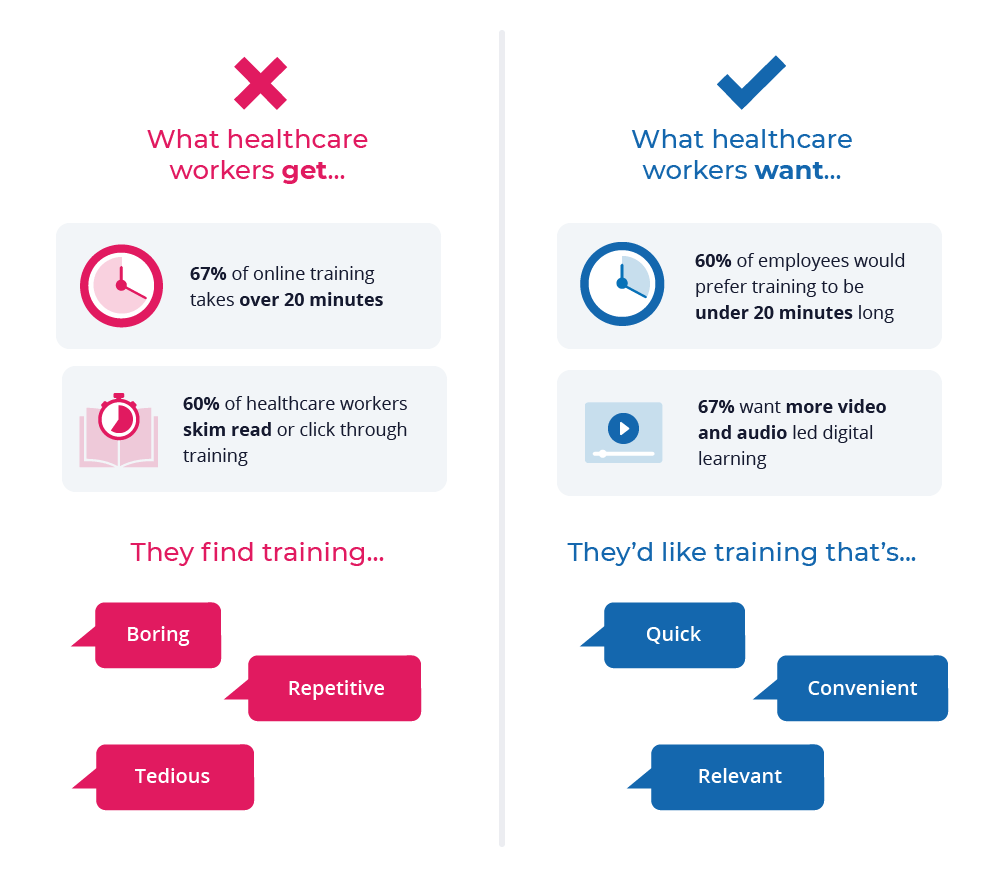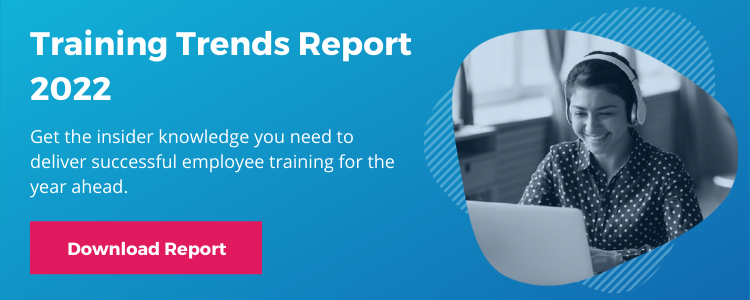3 key challenges for healthcare in 2023 and how to get ahead
4 minute read
The last few years have been marked by technological transformation and new approaches to healthcare provision. While practices continue to evolve in response to the pandemic, shifting patient expectations and evolving global regulations present new challenges. This article explores what healthcare L&D teams can do to keep pace and get ahead.

Data overview
From practitioners to administration, we wanted to find out what’s happening in today’s healthcare industry. We spoke to the teams who create learning experiences, and the employees who complete the training. Surveying over 25 professionals and more than 800 learners uncovered lots of insights. We’ve distilled this down to some key challenges and opportunities for the healthcare sector.
Find out more about this research in our Training Trends Report 2022.
Biggest challenges facing healthcare
The pandemic has transformed the way healthcare is provided. Despite previous resistance to change, the industry was quick to adapt. If providers are going to build from these changes, there are three key challenges they need to overcome.
1. New technology and approaches
When the pandemic reduced in-person human interaction, telehealth was rapidly adopted for consultation and soon became the norm. In fact, a McKinsey report highlighted 76% of consumers say they are highly or moderately likely to use telehealth in the future.
These new ways of working present many opportunities, but they also bring concerns. Whether its workflow integration or data security, many factors impact services effectiveness and compliance.
2. Shifting customer expectations
New technologies are changing customer expectations. From booking appointments to paying bills, Mail My Statements has highlighted the demand for a streamlined patient experience. But self-service requires a joined-up approach. It is essential to maintain compliance and avoid possibly fatal mishaps, as well as delivering a better patient experience.
3. Complex regulations
As regulatory bodies update standards to this new healthcare landscape, providers need to make sure their people and systems can keep up. Healthcare organizations offer a variety of services in different locations across the globe. From ethics to security, employees need to know the latest standards and how to apply them in their location.
With HIPAA Journal reporting high numbers of data breaches in the US, it’s clear there’s room for improvement when managing compliance risk.
Find out how to take your compliance training strategy from tick-box to transformational.
What does that mean for healthcare learning teams?
Demand is high for effective digital learning that helps healthcare businesses stay compliant and competitive. Expertise from across the organization needs to feed into elearning production. It’s key to ensuring training is up to date, accurate and meets a variety of ever-changing global regulations.
L&D teams must keep pace and get it right or risk serious patient errors. But over 80% of the learning leaders we surveyed were struggling to:
- Respond at speed
- Manage stakeholders
- Maintain quality
And once digital learning has been produced, the pressure doesn’t ease. 40% of leaders highlighted a lack of investment or budget. L&D teams need to demonstrate their value with improved compliance training and better customer experiences.
What is the modern learner in the healthcare industry looking for?
Just under 90% of healthcare organizations deliver most of their training online. So, what do their employees think about all this digital learning?

What can healthcare learning teams do to get ahead?
Start by exploring what your employees really want and need. Next, take these insights and create effective learning experiences that deliver the business impact and compliance you need. We’ve identified three digital learning trends that will help you.
1. Create impact with personalized blended learning
30% of businesses are exploring new hybrid ways learning. A modern approach to blended learning combines face-to-face and online learning alternatives, like Virtual Instructor-Led Training (VILT), webinars and elearning. It enables you to create personalized self-guided learning journeys that are relevant to different departments and locations.
Want to find out more? Explore our new blended learning strategies.
2. Make wellbeing a priority
The increased anxiety of the last few years has had a real impact on healthcare workers. Employee mental health was highlighted in our survey as a major focus in 2023. Part of this is about giving people the tools to better support their own wellbeing. But it’s also about putting them at the center of learning and development so they can develop the skills and knowledge to excel in their career.
3. Harness the power of video
Healthcare employees are calling out for more engaging learning. If you want to avoid your people clicking through elearning, join the 41% of learning leaders who are focusing on video. From sharing knowledge to telling stories, user-generated videos are a quick and easy way to get content out there. It gives a voice to your employees and encourages peer learning.
Discover even more elearning trends in the full corporate elearning trends article.
Summary
The healthcare sector is struggling to keep up with evolving international regulations, advancing technology and changing customer expectations. Stay ahead by taking a people-centered approach to your digital learning.
- Find out what your employees really want and need
- Drive impact and compliance with personalized blended learning journeys
- Focus on employee wellbeing and develop and retain your talent
- Provide the video learning employees want with user-generated content
By doing this, you’ll produce effective digital learning at speed and scale and overcome the healthcare sector’s key challenges.
If you want to find out more about the latest trends, read our full Training Trends Report 2022.




